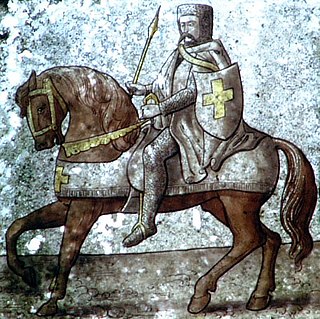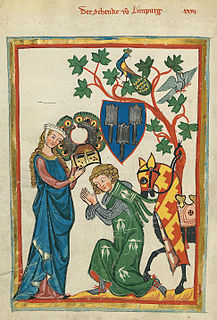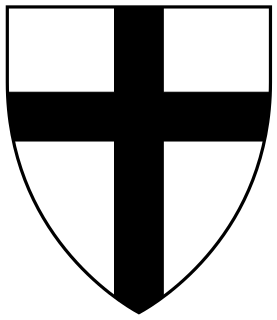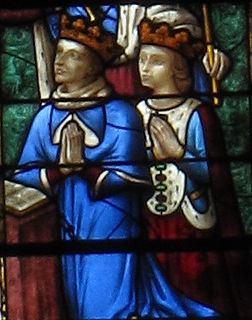
Jean II Le Maingre (in Old French: Jehan le Meingre), also known as Boucicaut (28 August 1366 – 21 June 1421), was a French knight who has been portrayed as an embodiment of chivalry. Renowned for his military skill, he was made a marshal of France.
Old French was the language spoken in Northern France from the 8th century to the 14th century. In the 14th century, these dialects came to be collectively known as the langue d'oïl, contrasting with the langue d'oc or Occitan language in the south of France. The mid-14th century is taken as the transitional period to Middle French, the language of the French Renaissance, specifically based on the dialect of the Île-de-France region.

A knight is a man granted an honorary title of knighthood by a monarch, bishop or other political or religious leader for service to the monarch or a Christian church, especially in a military capacity.

Chivalry, or the chivalric code, is an informal, varying code of conduct developed between 1170 and 1220, but never decided on or summarized in a single document. It was associated with the medieval Christian institution of knighthood; knights' and gentlewomen's behaviours were governed by chivalrous social codes. The ideals of chivalry were popularized in medieval literature, especially the Matter of Britain and Matter of France, the former based on Geoffrey of Monmouth's Historia Regum Britanniae, written in the 1130s, which introduced the legend of King Arthur. All of these were taken as historically accurate until the beginnings of modern scholarship in the 19th century.
He was the son of Jean I Le Maingre, also called Boucicaut and likewise a marshal of France. He became a page at the court of Charles VI of France, and at the age of 12 he accompanied Louis II, Duke of Bourbon, in a campaign against Normandy. At age 16 he was knighted by Louis on the eve of the Battle of Roosebeke (27 November 1382). In 1383 he began the first of his journeys that would take up more than twenty years of his life.

Jean I Le Meingre, also known as Le Boucicaut, Marshal of France was a 14th century French noble.

Charles VI, called the Beloved and the Mad, was King of France for 42 years from 1380 to his death in 1422, the fourth from the House of Valois.

Louis de Bourbon, called the Good, son of Peter de Bourbon and Isabella de Valois, was the third Duke of Bourbon.
In 1384 he undertook his first journey to Prussia, in order to assist the Teutonic Order in their war against the pagan Lithuanians, who would convert to Roman Catholicism in 1386. After some campaigns against the Moors in Spain, and against Toulouse in France he again accompanied the duke of Bourbon, this time to Spain, which had become a secondary battlefield of the Hundred Years' War. From there he travelled for two years through the Balkans, the Near East, and the Holy Land, in the company of his friend Renaud of Roye and later with Philip of Artois, Count of Eu. There, he and his companions composed the Livre des Cent Ballades, a poetical defense of the chaste knight the central figure of chivalry, which Johan Huizinga found a startling contrast with the facts of his military career. [1]

Prussia was a historically prominent German state that originated in 1525 with a duchy centred on the region of Prussia on the southeast coast of the Baltic Sea. It was de facto dissolved by an emergency decree transferring powers of the Prussian government to German Chancellor Franz von Papen in 1932 and de jure by an Allied decree in 1947. For centuries, the House of Hohenzollern ruled Prussia, successfully expanding its size by way of an unusually well-organised and effective army. Prussia, with its capital in Königsberg and from 1701 in Berlin, decisively shaped the history of Germany.

The Order of Brothers of the German House of Saint Mary in Jerusalem, commonly the Teutonic Order, is a Catholic religious order founded as a military order c. 1190 in Acre, Kingdom of Jerusalem.
Lithuanians are a Baltic ethnic group, native to Lithuania, where they number around 2,561,300 people. Another million or more make up the Lithuanian diaspora, largely found in countries such as the United States, Argentina, Brazil, Canada, Colombia, Russia, United Kingdom and Ireland. Their native language is Lithuanian, one of only two surviving members of the Baltic language family. According to the census conducted in 2001, 83.45% of the population of Lithuania identified themselves as Lithuanians, 6.74% as Poles, 6.31% as Russians, 1.23% as Belarusians, and 2.27% as members of other ethnic groups. Most Lithuanians belong to the Roman Catholic Church, while the Lietuvininkai who lived in the northern part of East Prussia prior to World War II, were mostly Evangelical Lutherans.

In 1390, while the Truce of Leulinghem had temporarily interrupted the war with England, Boucicaut and two other French knights set up the tournament of Saint-Inglevert, where he jousted, along with his two comrades, against redoubtable English knights, unhorsing three of his 18 opponents. The next year he travelled to Prussia for a third time. Because of his great service in the war against the heathens in Livonia and Prussia, he was named Marshal of France on 25 December 1391 by Charles VI at the cathedral of St. Martin in Tours.

The Truce of Leulinghem was a truce agreed to by Richard II's kingdom of England and its allies, and Charles VI's kingdom of France and its allies, on 18 July 1389, ending the second phase of the Hundred Years' War. England was on the edge of financial collapse and suffering from internal political divisions. On the other side, Charles VI was suffering from a mental illness that handicapped the furthering of the war by the French government. Neither side was willing to concede on the primary cause of the war, the legal status of the Duchy of Aquitaine and the King of England's homage to the King of France through his possession of the duchy. However, both sides faced major internal issues that could badly damage their kingdoms if the war continued. The truce was originally negotiated by representatives of the kings to last three years, but the two kings met in person at Leulinghem, near the English fortress of Calais, and agreed to extend the truce to a twenty-seven years' period. Other provisions were agreed to, in attempts to bring an end to the papal schism, to launch a joint crusade against the Turks in the Balkans, to seal the marriage of Richard to Charles' daughter Isabella along with an 800,000 franc dowry, and to guarantee to continue peace negotiations, in order to establish a lasting treaty between the kingdoms. The treaty brought peace to the Iberian peninsula, where Portugal and Castile were supporting the English and French respectively. The English evacuated all their holdings in northern France except Calais.

The Hundred Years' War was a series of conflicts waged from 1337 to 1453 by the House of Plantagenet, rulers of the Kingdom of England, against the French House of Valois, over the right to rule the Kingdom of France. Each side drew many allies into the war. It was one of the most notable conflicts of the Middle Ages, in which five generations of kings from two rival dynasties fought for the throne of the largest kingdom in Western Europe. The war marked both the height of chivalry and its subsequent decline, and the development of strong national identities in both countries.

A tournament, or tourney, was a chivalrous competition or mock fight in Europe in the Middle Ages and Renaissance. It is one type of hastilude.
In 1396 he took part in the joint French-Hungarian crusade against the Ottoman Empire, which suffered a heavy defeat on September 28 at the Battle of Nicopolis. He was taken hostage by the Ottoman sultan Bayezid I, but, unlike many of his companions, escaped execution and was eventually ransomed. In 1399, he founded the Emprise de l'Escu vert à la Dame Blanche, a chivalric order inspired by the ideal of courtly love: "one might have supposed him cured of all chivalrous delusions after the catastrophe of Nicopolis", remarked Huizinga. [2] In the same year, he was sent with six ships carrying 1,200 men to assist Byzantine emperor Manuel II Palaeologus against the Ottomans.

Hungary is a country in Central Europe. Spanning 93,030 square kilometres (35,920 sq mi) in the Carpathian Basin, it borders Slovakia to the north, Ukraine to the northeast, Austria to the northwest, Romania to the east, Serbia to the south, Croatia to the southwest, and Slovenia to the west. With about 10 million inhabitants, Hungary is a medium-sized member state of the European Union. The official language is Hungarian, which is the most widely spoken Uralic language in the world, and among the few non-Indo-European languages to be widely spoken in Europe. Hungary's capital and largest city is Budapest; other major urban areas include Debrecen, Szeged, Miskolc, Pécs and Győr.

The Ottoman Empire, historically known in Western Europe as the Turkish Empire or simply Turkey, was a state that controlled much of Southeast Europe, Western Asia and North Africa between the 14th and early 20th centuries. It was founded at the end of the 13th century in northwestern Anatolia in the town of Söğüt by the Oghuz Turkish tribal leader Osman I. After 1354, the Ottomans crossed into Europe, and with the conquest of the Balkans, the Ottoman beylik was transformed into a transcontinental empire. The Ottomans ended the Byzantine Empire with the 1453 conquest of Constantinople by Mehmed the Conqueror.

The Battle of Nicopolis took place on 25 September 1396 and resulted in the rout of an allied crusader army of Hungarian, Croatian, Bulgarian, Wallachian, French, English, Burgundian, German and assorted troops at the hands of an Ottoman force, raising of the siege of the Danubian fortress of Nicopolis and leading to the end of the Second Bulgarian Empire. It is often referred to as the Crusade of Nicopolis as it was one of the last large-scale Crusades of the Middle Ages, together with the Crusade of Varna in 1443–1444.
In 1401, due to his military accomplishments and his knowledge of the east, he was appointed French governor of Genoa, which had fallen to Charles VI in 1396. He successfully repelled an attack from King Janus of Cyprus, who tried to take back the city of Famagusta on Cyprus, which had been captured by Genoa. On his return, he was defeated by the Venetians at the Battle of Modon on 7 October 1403. After some struggles in the Mediterranean the Genoese freed themselves from French rule by 1409.

Genoa is the capital of the Italian region of Liguria and the sixth-largest city in Italy. In 2015, 594,733 people lived within the city's administrative limits. As of the 2011 Italian census, the Province of Genoa, which in 2015 became the Metropolitan City of Genoa, counted 855,834 resident persons. Over 1.5 million people live in the wider metropolitan area stretching along the Italian Riviera.

Janus of Cyprus was a King of Cyprus and titular King of Armenian Cilicia and Jerusalem from 1398 to 1432.

Famagusta is a city on the east coast of Cyprus. It is located east of Nicosia and possesses the deepest harbour of the island. During the medieval period, Famagusta was the island's most important port city and a gateway to trade with the ports of the Levant, from where the Silk Road merchants carried their goods to Western Europe. The old walled city and parts of the modern city presently fall within the de facto Turkish Republic of Northern Cyprus in Gazimağusa District, of which it is the capital.
Boucicaut returned to France and became involved in the rivalry between Burgundy and Orléans. In the Battle of Agincourt in 1415 he commanded the French vanguard, but was captured by the English and died six years later in Yorkshire. He was buried in the cathedral of Tours, in his family's chapel, with the epitaph "Grand Constable of the Emperor and of the Empire of Constantinople."








